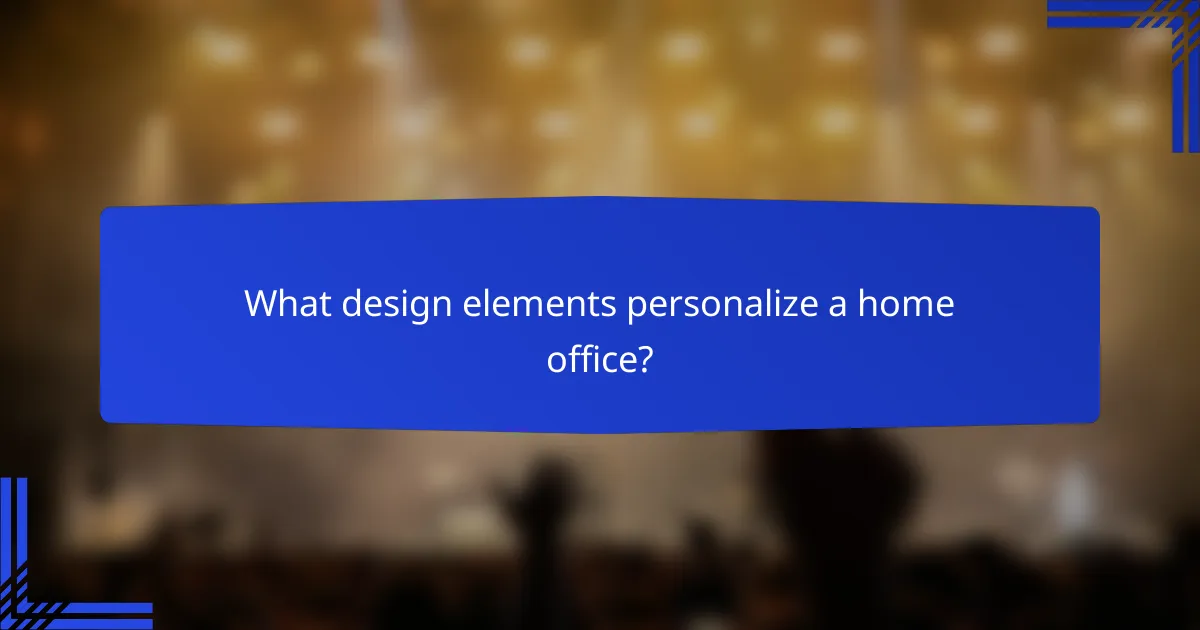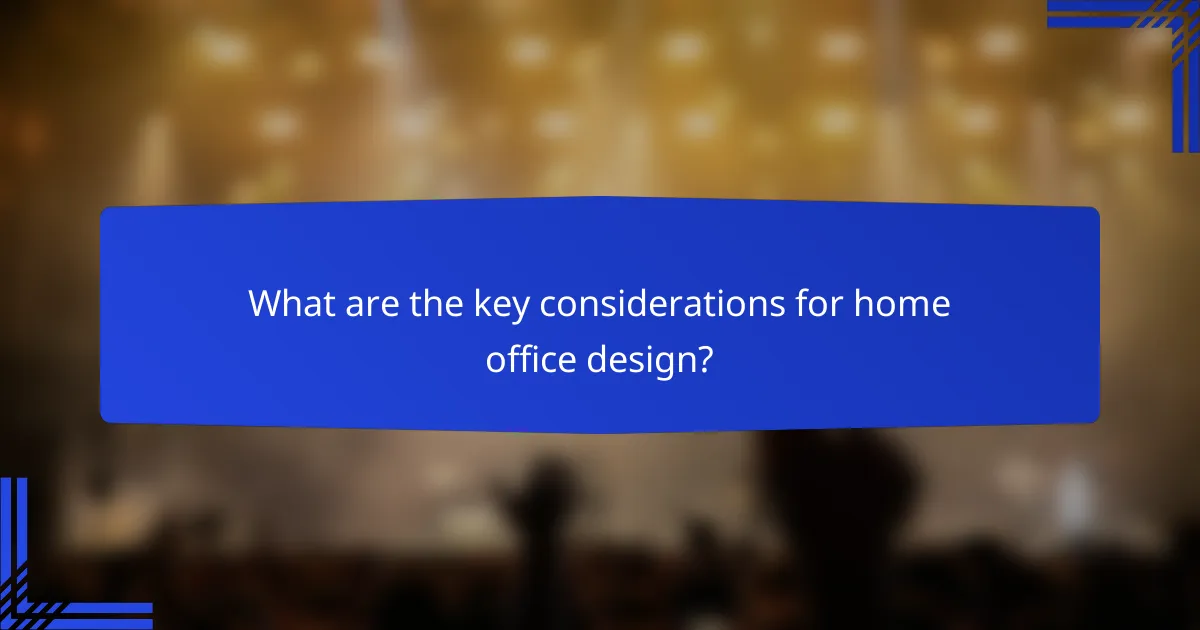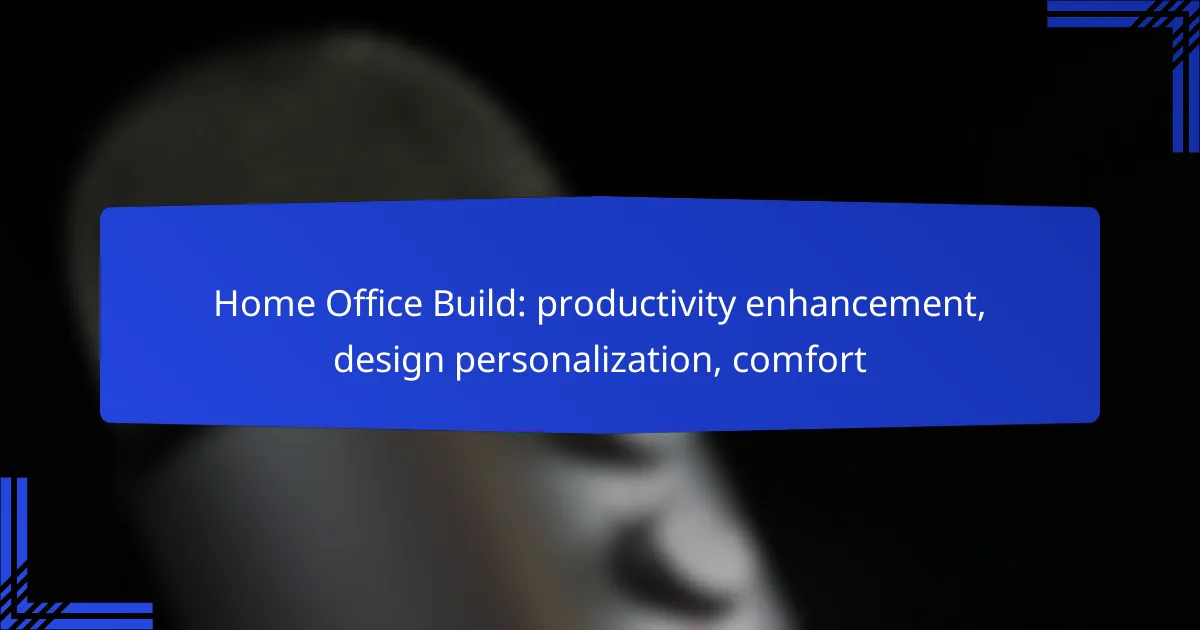Creating an effective home office is essential for boosting productivity and ensuring comfort while you work. By focusing on ergonomic furniture, personalized design elements, and a comfortable atmosphere, you can craft a space that not only reflects your style but also enhances your efficiency. Prioritizing these aspects will lead to improved focus and overall job satisfaction.

How can I enhance productivity in my home office?
Enhancing productivity in your home office involves creating an environment that supports focus, comfort, and efficiency. Key elements include ergonomic furniture, effective lighting, sound management, and the right tools for time and task management.
Ergonomic furniture
Investing in ergonomic furniture is crucial for maintaining comfort during long work hours. Look for chairs that support your lower back and desks that allow for both sitting and standing positions. Adjustable features can help accommodate different body types and preferences.
Consider using a chair with adjustable armrests and lumbar support. A height-adjustable desk can promote better posture and reduce fatigue, allowing you to switch between sitting and standing throughout the day.
Task lighting solutions
Proper task lighting can significantly impact your productivity by reducing eye strain and improving focus. Use adjustable desk lamps that provide bright, direct light for reading and writing tasks. Aim for lighting that mimics natural daylight to enhance alertness.
Consider layering your lighting with ambient and task options. Dimmable lights can help you adjust brightness based on the time of day or your specific needs, creating a more comfortable work environment.
Noise-canceling technology
Noise-canceling technology can help minimize distractions in your home office, leading to improved concentration. Invest in quality noise-canceling headphones or soundproofing materials to create a quieter workspace.
Consider using white noise machines or apps that generate soothing sounds to mask background noise. This can be particularly beneficial in shared living spaces or urban environments where external sounds can disrupt focus.
Time management tools
Effective time management tools can help you structure your workday and maintain focus on tasks. Utilize planners, calendars, or digital tools to set deadlines and prioritize your workload. Techniques like the Pomodoro Technique can enhance productivity by breaking work into manageable intervals.
Try setting specific time blocks for different tasks and use timers to keep yourself accountable. Regularly reviewing your progress can help you adjust your strategies and improve efficiency over time.
Productivity apps
Productivity apps can streamline your workflow and help you stay organized. Look for applications that offer task management, note-taking, and collaboration features to enhance your efficiency. Popular options include Trello, Asana, and Notion.
Choose apps that integrate well with your existing tools and devices. Many productivity apps offer free versions with essential features, allowing you to test their effectiveness before committing to a subscription.

What design elements personalize a home office?
Personalizing a home office involves selecting design elements that reflect your style and enhance productivity. Key aspects include color choices, custom shelving, artwork, and the overall layout of the workspace.
Color psychology
Color psychology plays a significant role in how we feel and perform in our workspaces. For instance, blue hues can promote calmness and focus, while yellow can inspire creativity. When choosing colors, consider the emotional response you want to evoke in your home office.
Try using a color palette that resonates with your personality and work style. Soft neutrals can create a serene environment, while vibrant accents can energize the space. Aim for a balance that fosters both comfort and productivity.
Custom shelving options
Custom shelving can enhance both functionality and aesthetics in your home office. Consider built-in shelves that fit your specific needs, whether for books, supplies, or decorative items. Adjustable shelving can also provide flexibility as your requirements change.
When designing shelving, think about materials and finishes that complement your overall decor. Open shelving can create an airy feel, while closed cabinets can help reduce clutter. Ensure that your shelving is easily accessible to maintain an organized workspace.
Artwork and decor choices
Artwork and decor choices can significantly impact your home office’s atmosphere. Select pieces that inspire you, such as motivational quotes, landscapes, or abstract art. Personal touches can make the space feel uniquely yours and enhance your mood while working.
Consider incorporating a mix of textures and styles to create visual interest. Use frames that match your office’s color scheme and theme. Additionally, plants can add a touch of nature, improving air quality and providing a calming effect.
Personalized workspace layout
A personalized workspace layout is crucial for maximizing comfort and efficiency. Start by determining your primary work activities and arrange your desk, chair, and equipment accordingly. Ensure that your setup allows for easy movement and access to frequently used items.
Experiment with different configurations to find what works best for you. For example, a standing desk can promote better posture, while a cozy reading nook can provide a space for breaks. Keep ergonomics in mind to prevent strain and enhance productivity.

How does comfort affect home office productivity?
Comfort plays a crucial role in enhancing home office productivity by reducing distractions and promoting focus. A comfortable workspace allows individuals to work more efficiently, leading to better performance and overall job satisfaction.
Climate control systems
Effective climate control systems, such as heating, ventilation, and air conditioning (HVAC), are essential for maintaining a comfortable home office environment. Proper temperature regulation can help prevent fatigue and enhance concentration, with ideal temperatures typically ranging from 20°C to 22°C (68°F to 72°F).
Consider investing in programmable thermostats or smart HVAC systems that allow for easy adjustments based on personal preferences. Additionally, using fans or space heaters can provide localized comfort without affecting the entire home.
Comfortable seating options
Choosing the right seating is vital for comfort and productivity in a home office. Ergonomic chairs that support the lower back and promote good posture can reduce discomfort during long working hours.
When selecting a chair, look for features such as adjustable height, lumbar support, and breathable materials. Budget-friendly options can range from $100 to $500, while high-end ergonomic chairs may exceed $1,000.
Adjustable standing desks
Adjustable standing desks offer the flexibility to alternate between sitting and standing, which can enhance comfort and reduce the risk of musculoskeletal issues. Studies suggest that standing desks can improve energy levels and reduce fatigue, making them a popular choice for home offices.
When considering a standing desk, look for models that are easy to adjust and sturdy enough to support your equipment. Prices typically range from $200 to $800, depending on features and quality. Aim for a desk height that allows your elbows to be at a 90-degree angle when typing to maintain ergonomic posture.

What are the key considerations for home office design?
Key considerations for home office design include optimizing space, ensuring proper lighting, and integrating technology effectively. These elements contribute to productivity, comfort, and personalization, allowing for a workspace that meets individual needs.
Space optimization techniques
To maximize space in a home office, consider multifunctional furniture such as desks with built-in storage or foldable tables. Utilizing vertical space with shelves can also help keep the area organized while providing easy access to essential items.
It’s beneficial to create defined zones within the office, separating areas for work, relaxation, and storage. This can enhance focus and efficiency, making it easier to switch between tasks without distractions.
Lighting and ambiance
Effective lighting is crucial for a productive home office. Natural light is ideal, so position your desk near windows when possible. If natural light is limited, opt for adjustable LED lights that mimic daylight to reduce eye strain and improve mood.
Incorporating ambient lighting, such as floor lamps or wall sconces, can create a comfortable atmosphere. Consider using dimmers to adjust brightness levels based on the time of day or specific tasks.
Technology integration
Integrating technology into your home office can significantly enhance productivity. Ensure you have reliable internet access and consider investing in ergonomic devices like adjustable monitors and keyboards to promote comfort during long work hours.
Smart home devices, such as voice-activated assistants or automated lighting, can streamline tasks and improve efficiency. Regularly update software and security measures to protect your data and maintain a smooth workflow.

What are the best home office furniture brands?
Some of the best home office furniture brands include IKEA, Herman Miller, and Steelcase. These brands are known for their quality, ergonomic designs, and a variety of options that cater to different styles and budgets.
IKEA office solutions
IKEA offers a wide range of office solutions that are both functional and affordable. Their modular furniture allows for customization, enabling you to create a workspace that fits your specific needs and preferences.
Consider their desks, shelving units, and storage solutions, which often come at competitive prices, typically ranging from $50 to $500. Look for items that maximize space and provide organization to enhance productivity.
Herman Miller ergonomic chairs
Herman Miller is renowned for its ergonomic chairs designed to support long hours of work. Their chairs, such as the Aeron and Embody, are engineered to promote good posture and reduce discomfort.
Prices for Herman Miller chairs generally start around $1,000, reflecting their premium quality and durability. Investing in a good ergonomic chair can significantly enhance comfort and productivity in your home office.
Steelcase desks
Steelcase desks are known for their sturdy construction and innovative designs. They offer a variety of styles, including sit-stand options that allow you to alternate between sitting and standing throughout the day.
Prices for Steelcase desks typically range from $500 to $2,000, depending on the features and materials. When selecting a desk, consider your workspace layout and how the desk’s design can facilitate your workflow.

How can I create a distraction-free environment?
To create a distraction-free environment, focus on minimizing interruptions and optimizing your workspace layout. This involves organizing your area, managing noise levels, and eliminating visual clutter.
Organizing Your Workspace
Start by decluttering your desk and removing items that are not essential for your work. Use organizers or storage solutions to keep supplies neatly arranged. A clean and orderly workspace can significantly enhance focus and productivity.
Consider the layout of your workspace. Position your computer screen at eye level and ensure that frequently used items are within easy reach. This setup reduces unnecessary movements and distractions.
Managing Noise Levels
Noise can be a significant distraction, so consider using noise-canceling headphones or playing soft background music to help maintain concentration. If you work from home, communicate with family members about your work hours to minimize interruptions.
For those in shared spaces, soundproofing options like rugs, curtains, or acoustic panels can help absorb noise. Creating a quieter environment can lead to improved focus and efficiency.
Eliminating Visual Clutter
Visual distractions can disrupt your workflow, so aim to keep your workspace visually appealing and simple. Limit the number of personal items displayed and choose a calming color palette for your office decor.
Additionally, use digital tools to reduce visual clutter on your computer. Organize files into folders and close unnecessary tabs to create a streamlined digital workspace that promotes focus.
